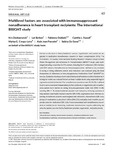Multilevel factors are associated with immunosuppressant nonadherence in heart transplant recipients: the international BRIGHT study

View/
Use this link to cite
http://hdl.handle.net/2183/37005
Except where otherwise noted, this item's license is described as Creative Commons Attribution-NonCommercial-NoDerivs 4.0 International License (CC-BY-NC-ND 4.0)
Collections
- Investigación (FCS) [1293]
Metadata
Show full item recordTitle
Multilevel factors are associated with immunosuppressant nonadherence in heart transplant recipients: the international BRIGHT studyAuthor(s)
Date
2017-12-05Citation
Denhaerynck K, Berben L, Dobbels F, Russell CL, Crespo-Leiro MG, Poncelet AJ, De Geest S; BRIGHT study team. Multilevel factors are associated with immunosuppressant nonadherence in heart transplant recipients: the international BRIGHT study. Am J Transplant. 2018 Jun;18(6):1447-1460.
Abstract
[Abstract] Factors at the level of family/healthcare worker, organization, and system are neglected in medication nonadherence research in heart transplantation (HTx). The 4-continent, 11-country cross-sectional Building Research Initiative Group: Chronic Illness Management and Adherence in Transplantation (BRIGHT) study used multistaged sampling to examine 36 HTx centers, including 36 HTx directors, 100 clinicians, and 1397 patients. Nonadherence to immunosuppressants-defined as any deviation in taking or timing adherence and/or dose reduction-was assessed using the Basel Assessment of Adherence to Immunosuppressive Medications Scale© (BAASIS© ) interview. Guided by the Integrative Model of Behavioral Prediction and Bronfenbrenner's ecological model, we analyzed factors at these multiple levels using sequential logistic regression analysis (6 blocks). The nonadherence prevalence was 34.1%. Six multilevel factors were associated independently (either positively or negatively) with nonadherence: patient level: barriers to taking immunosuppressants (odds ratio [OR]: 11.48); smoking (OR: 2.19); family/healthcare provider level: frequency of having someone to help patients read health-related materials (OR: 0.85); organization level: clinicians reporting nonadherent patients were targeted with adherence interventions (OR: 0.66); pickup of medications at physician's office (OR: 2.31); and policy level: monthly out-of-pocket costs for medication (OR: 1.16). Factors associated with nonadherence are evident at multiple levels. Improving medication nonadherence requires addressing not only the patient, but also family/healthcare provider, organization, and policy levels.
Keywords
Clinical decision-making
Clinical research/practice
Compliance/adherence
Heart transplantation/cardiology
Immunosuppression/immune modulation
Social sciences
Clinical research/practice
Compliance/adherence
Heart transplantation/cardiology
Immunosuppression/immune modulation
Social sciences
Editor version
Rights
Creative Commons Attribution-NonCommercial-NoDerivs 4.0 International License (CC-BY-NC-ND 4.0)
ISSN
1600-6135






